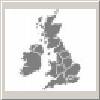Please note that the NBN Gateway map service has been terminated as of 1 April 2017.
As soon as a replacement map service is available, distribution maps will hopefully appear here again.
In the meantime, you can get some idea of distribution from the NBN Atlas website.
63.064 BF1334
Scoparia ambigualis
(Treitschke, 1829)
Wingspan 15-22 mm.
One of several very similar moths which can be rather difficult to separate.
The adults fly from May to July, and can be found resting on tree-trunks or rocks.
A common species throughout Britain, though until recently, the early stages have been undescribed.
- Larva: (description I.F. Smith ):
Food: Moss and/or organic detritus under moss. On marshy ground, or near bracken. November, or earlier, to June.
Length: 13 mm.
Head: Mid brown with black posterior and anterior edges.
Prothoracic shield: Shiny dark brown.
Thorax: Segments T2 & T3 dark brown with large blackish pinacula (two on dorsum of each segment).
Thoracic legs: Dark brown and blackish.
Abdomen: Dark brown with indistinct grey gut showing dorsally. Greenish grey in May, June. Very large blackish pinacula (four on dorsum of each segment).
Spiracles: Black
Setae: Black at base, fading distally to colourless transparent.
Anal plate: Blackish with small reddish marks.
Prolegs: Dark brown at base. Planta whitish with small black spot. Double circle of grey-black crochets. Anal prolegs encased in long blackish pinaculum.Similar Species: Larvae of several species of Scopariinae are similar, with very large pinacula. They should be reared to confirm identification. For a more detailed description, including chaetotaxy, of S. ambigualis see; Smith, I.F., (in press). A description of the larva of Scoparia ambigualis (Treitschke, 1829) (Lepidoptera: Pyralidae). Entomologist?s Gazette (publication due 2004).
Rearing: Keep in plastic box with transparent lid in North facing window. Provide sample of moss and organic material found with larva. Wash the moss and sterilize the detritus in a microwave. Wipe out condensation. Raising indoors will result in early emergence.

 UKMoths
UKMoths 





